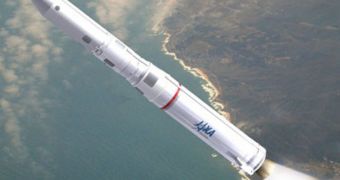Officials at the Japanese Space Activities Commission say that they have authorized experts to continue development work on the first successor of the sample-return probe Hayabusa. A new rocket called Epsilon has also received approval.
The Commission is the board that is in charge of establishing the directions and priorities of the Japanese space program, which is managed by the Japan Aerospace Exploration Agency (JAXA).
In June, the Hayabusa space probe returned from the near-Earth object (NEO) Itokawa, an asteroid which the ship targeted since 2003.
After safely parachuting its container capsules in the Australian desert, the mission became the first ever to successfully land on a NEO, collect samples, and then return them to Earth.
The spacecraft spent about seven years in space, during which time everything that could have possible gone wrong did. It was only through the dedication and inventiveness of the engineers controlling it that the spacecraft made it home.
The new spacecraft will most likely be completed and launched by 2014. It will head towards a carbon-rich asteroid, and is scheduled to land on one around 2018.
During the touch-and-go operation, the Hayabusa 2 probe will collect additional samples, which may help geologists and planetary scientists gain more clues as to how the solar system formed and evolved.
The data could also help track down the origin of life in the solar system, given that may scientists believe life arrived on Earth via comets or asteroids.
The second goal of the new space program is the small satellite launch vehicle called Epsilon. The project is managed by JAXA expert Yasuhiro Morita, Space reports.
“We've already spent three years on the preliminary design. This is the actual start of the development. This is a good time for us,” the official says.
He adds that the new vehicle is meant as a replacement platform for the M-5 rocket, which flew between 1997 and 2006. M-5 completed seven successful flights.
According to officials at JAXA, the Epsilon could make its maiden voyage as soon as 2013. The rocket will be able to carry as much as 2,600 pounds of cargo to low-Earth orbit (LEO).
This carrying capacity is lower than M-5's, which could carry about 4,000 pounds to similar altitudes.
“One of the most remarkable features of the Epsilon rocket is its mobility, so the vehicle can be launched by Uchinoura [Spaceport] as well as by Tanegashima, and the government has not yet decided its launch site,” Morita reveals.
“The small rocket will be required for small satellite missions. The H-2A is too big to support small satellites. We need a small launcher with the responsiveness to support small satellites,” he concludes.

 14 DAY TRIAL //
14 DAY TRIAL //